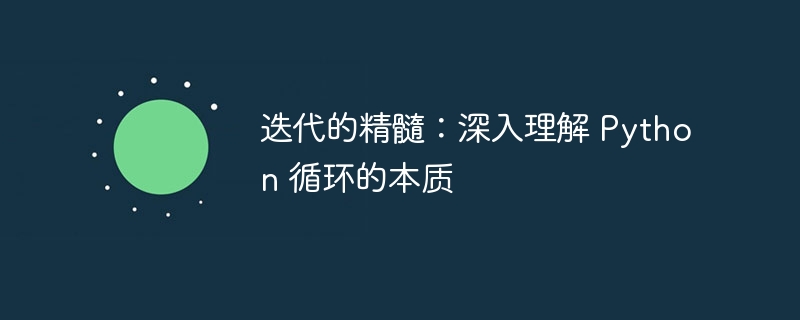Home >Backend Development >Python Tutorial >The Essence of Iteration: A Deeper Understanding of the Nature of Loops in Python
The Essence of Iteration: A Deeper Understanding of the Nature of Loops in Python
- 王林forward
- 2024-02-19 22:12:03467browse

Understand the nature of loops
A loop is a control flow mechanism that allows you to execute a block of code repeatedly based on specific conditions. python provides two main types of loops: for loops and while loops.
-
forLoop: Used to traverse a sequence, such as a list or tuple. It starts at the beginning of the sequence and goes through each element one by one until it reaches the end. -
whileLoop: Used to repeatedly execute a block of code until a specific condition is met. It continuously evaluates the conditional expression and executes the block of code when the condition isTrue.
for Loop
for The syntax of the loop is as follows:
for item in sequence: # 代码块
in:
-
itemis a local variable in the loop that stores the current element of the sequence. -
sequenceis the sequence you want to iterate over.
Demo code:
colors = ["red", "blue", "green"]
for color in colors:
print(f"The color is {color}")
# 输出:
# The color is red
# The color is blue
# The color is green
while Loop
while The syntax of the loop is as follows:
while condition: # 代码块
in:
-
conditionis a Boolean expression that determines whether to repeat a block of code.
Demo code:
count = 1
while count <= 10:
print(f"Current count: {count}")
count += 1
# 输出:
# Current count: 1
# Current count: 2
# ...
# Current count: 10
Advanced usage
In addition to basic usage, Python loops also have the following advanced usage:
-
breakStatement: is used to exit the loop immediately. -
continueStatement: is used to skip the current iteration and continue with the next iteration. - Iterators: can be used to customize loop behavior and traverse various data structures .
The role of iterator
Iterators play a vital role in Python loops. An iterator is an object that provides a traversable interface over its elements. When you use a for loop, the underlying iterator method is automatically called to get the elements of the sequence.
Demo code:
class MyRange: def __init__(self, start, end): self.start = start self.end = end def __iter__(self): current = self.start while current < self.end: yield current current += 1 for number in MyRange(1, 10): print(number) # 输出: # 1 # 2 # ... # 9
in conclusion
Python loops are powerful tools used to control program flow and process data. By understanding the nature of for loops and while loops, and taking advantage of advanced usage and iterators, you can write efficient and maintainable code. Mastering the essence of Python loops will significantly improve your programming skills.
The above is the detailed content of The Essence of Iteration: A Deeper Understanding of the Nature of Loops in Python. For more information, please follow other related articles on the PHP Chinese website!
Related articles
See more- Detailed explanation on the submission usage of form form submit and button in html
- Detailed explanation of the iterator pattern of PHP design patterns
- How to use the while loop statement in JavaScript
- How to end a loop in python
- How to use do...while statement to find the cumulative sum from 1 to 100 in C language

